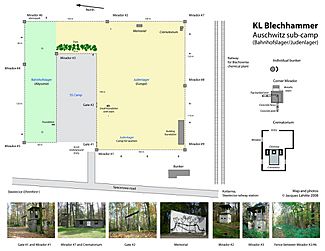Blechhammer facts for kids
Quick facts for kids Blechhammer |
|
|---|---|
| Part of Provinz Schlesien of Greater Germany | |
| Located in Upper Silesia | |

Blechhammer map of Bahnhofslager/Judenlager
|
|
| Coordinates | North plant 50°21′N 18°18′E / 50.350°N 18.300°E South plant 50°18′N 18°15′E / 50.300°N 18.250°E |
| Site history | |
| In use | 1942–1945 (50,000 POWs) |
| Battles/wars | Oil Campaign of World War II |
| Events | 1944-05: flak guns added 1945-01-21: The March (1945) |
Blechhammer was an important area in Nazi Germany during World War II. It was known for its chemical factories, which made fuel, and for its many camps. These camps held prisoners of war (POWs) and people forced to work.
The name "Blechhammer" means "sheet metal hammer" in English. Prisoners started arriving at these camps as early as June 1942. By July 1944, many people were moved here from other camps. Blechhammer became a satellite camp of the famous Auschwitz concentration camp, which was a very harsh place.
Contents
Making Fuel for the War
The Blechhammer area had two main chemical factories: Blechhammer North and Blechhammer South. These factories were about 2 miles (3 km) apart. Allied pilots, who flew planes to bomb these sites, sometimes called them "Black Hammer."
How Synthetic Oil Was Made
These factories were very important because they made synthetic oil. This was a special type of oil created from bituminous coal (a type of black coal). Germany needed this oil to power its military vehicles and planes during the war. It was a way to make fuel when natural oil was scarce.
Bombing Campaigns
In June 1944, the United States Army Air Forces saw Blechhammer as one of Germany's most important synthetic oil factories. Allied planes dropped thousands of tons of bombs on these plants. After the war, the factories were taken apart by the Soviets.
The Camps and Evacuation
The Blechhammer complex included several POW camps and forced labor camps. Life in these camps was extremely difficult.
Forced Marches
As the war ended in January 1945, prisoners from the labor camps were forced to march long distances. These were known as "death marches." Many prisoners suffered greatly during these journeys. Some small groups of prisoners managed to escape during this time.
Accounts from Survivors
We know about what life was like at Blechhammer from diaries and stories of survivors. For example, Reg Beattie, a POW, wrote about his experiences in his diary called Captive Plans. A Czech journalist named František R. Kraus also shared his story as a survivor.
See also
- Oil Campaign of World War II
- Monowitz concentration camp

